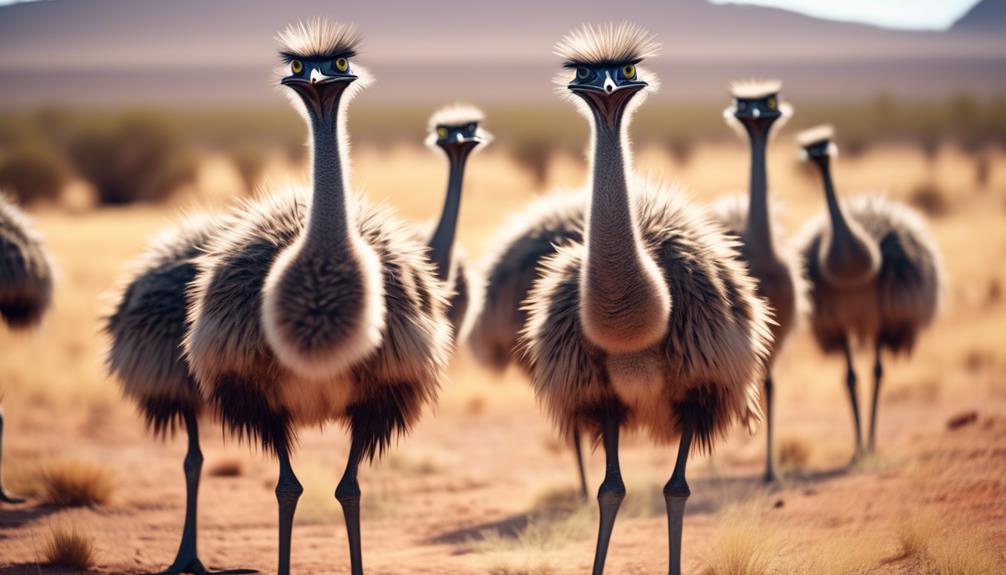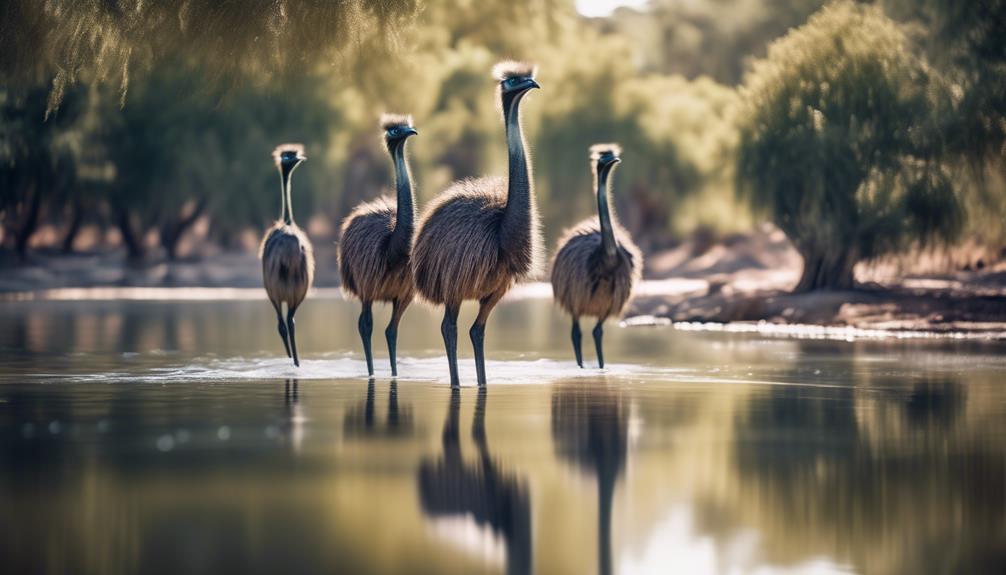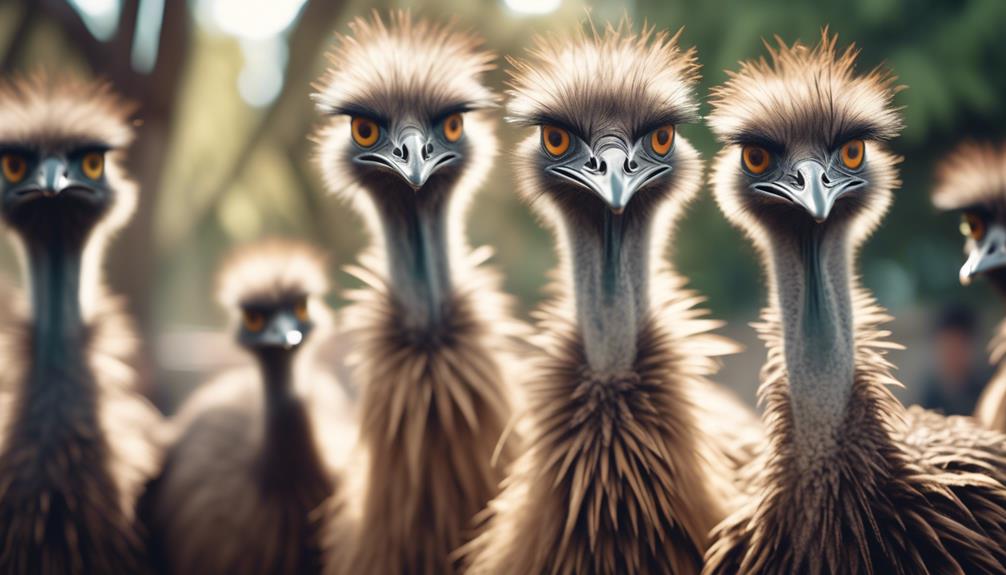
Did you know that emus are not only excellent runners but also skilled swimmers? These fascinating birds, native to Australia, have some incredible abilities that you probably didn't know about.
From their unique appearance to their complex social structure, emus are full of surprises.
So, if you're curious to learn more about these intriguing creatures and uncover some lesser-known facts, then keep on reading. You won't want to miss out on discovering the top 10 facts about emus that will leave you amazed.
Emus Are the Second Largest Birds

Emus, known for their impressive size and stature, hold the distinction of being the second largest birds in the world. Standing up to 6 feet tall and weighing around 100 pounds, these flightless birds are surpassed in size only by their distant relatives, the ostriches. Emus can be found both in the wild and in captivity, with a significant population thriving in Australia, their native land.
In captivity, emus are often kept for their meat, eggs, and feathers. Their meat is low in fat and cholesterol, making it a popular choice for health-conscious individuals. Emu eggs are also prized for their large size and rich taste, often used in cooking and baking. Additionally, emu feathers are valued for their beauty and durability, used in various crafts and fashion industries.
In Australian culture, emus hold a special place. They're featured in Aboriginal Dreamtime stories and are considered a sacred animal by some indigenous communities. Emu feathers have been used in traditional ceremonies and dances, symbolizing strength and spirituality.
Emus Have Unique Feathers and Appearance
With their unique feathers and striking physical features, emus possess a distinct appearance that sets them apart from other avian species. These evolutionary adaptations have allowed emus to thrive in their natural habitats and have also given them cultural significance among different communities. Here are four interesting facts about emus' feathers and appearance:
- Double-layered feathers: Emus have two layers of feathers, providing them with excellent insulation. The outer layer consists of coarse, loose feathers that help repel water and protect against harsh weather conditions. The inner layer is soft and downy, providing insulation and keeping the emu warm in cold temperatures.
- Vibrant blue neck and head: One of the most distinctive features of the emu is its vibrant blue neck and head. This coloring is caused by a combination of structural coloration and pigmentation. The blue color is believed to play a role in communication and mate selection.
- Powerful legs and clawed feet: Emus have long, powerful legs and clawed feet that enable them to run at high speeds and kick with great force. These adaptations have evolved to help emus defend themselves, escape from predators, and navigate their environments.
- Feathered body and reduced wing size: Emus have a feathered body, with the exception of their wings, which are reduced in size and unable to support flight. Instead, their wings assist in balance and stability while running, as well as display during courtship rituals.
Emus' unique feathers and appearance not only showcase their remarkable evolutionary adaptations but also hold cultural significance in various societies. Whether it be through their vibrant blue necks or powerful legs, emus continue to captivate and intrigue both scientists and observers alike.
Emus Are Excellent Runners

Emus are renowned for their exceptional running abilities, allowing them to reach impressive speeds and outpace many potential predators in their native habitats. These flightless birds possess long, powerful legs that enable them to cover ground swiftly and efficiently. Emus' running speed is truly remarkable, with adults reaching speeds of up to 30 miles per hour (48 kilometers per hour). This incredible pace, combined with their agile maneuverability, makes it challenging for predators to catch them.
Emus' running technique is also worth noting. They've a unique gait, which involves both legs on one side moving simultaneously, followed by the legs on the other side. This motion, known as bipedal locomotion, allows emus to maintain balance and conserve energy while running. Their strong leg muscles, particularly the thigh and calf muscles, provide the necessary power for their impressive speed.
When running, emus hold their wings close to their bodies, reducing wind resistance and enhancing their speed. They also utilize their long necks and heads to maintain balance and stability while in motion. Additionally, emus' large, three-toed feet serve as excellent shock absorbers, enabling them to navigate various terrains, including grasslands, forests, and even sandy dunes.
Emus Have a Fascinating Mating Ritual
During their mating season, emus engage in a captivating and intricate courtship ritual characterized by distinctive behaviors and vocalizations. This ritual serves as a display of the male emu's fitness and attracts potential mates. Here are some fascinating aspects of the emus' mating dance:
- Elaborate Movements: The male emu begins by puffing up his feathers and extending his neck, creating an impressive display of size and dominance. He then performs a series of intricate movements, including hopping, spinning, and swaying from side to side. These motions showcase his agility and strength to the female emus.
- Drumming Sounds: As the male emu performs his dance, he produces deep drumming sounds by vibrating his throat and inflating his vocal sacs. These unique vocalizations resonate through the surrounding environment, capturing the attention of nearby females. The rhythmic beat of the drumming sound is believed to communicate the male's fitness and genetic quality.
- Wooing Calls: Along with the drumming sounds, the male emu also emits low-frequency, booming calls. These calls serve as an additional attraction to the females and help establish the male's presence in the area. The calls can be heard from a considerable distance and are an essential part of the emus' courtship ritual.
- Tail Feathers Display: Another intriguing aspect of the emus' mating dance is the male's display of his impressive tail feathers. He raises and spreads his feathers, showcasing their beautiful pattern and vibrant colors. This visual spectacle, combined with the drumming sounds and wooing calls, further entices the females and increases the chances of successful mating.
Emus' mating dance and unique vocalizations create a mesmerizing courtship ritual, demonstrating the male's fitness and captivating the interest of potential mates. Witnessing this intricate display provides a glimpse into the fascinating world of emu reproduction.
Emus Are Skilled Swimmers

Emus, being large and flightless birds, possess remarkable swimming abilities that are a testament to their adaptability and survival instincts. Despite their bulky appearance, emus are surprisingly agile in the water. They've evolved specialized adaptations that allow them to navigate through various water bodies with ease.
Emus are known to be cautious around water, displaying a strong sense of water safety. Before entering the water, they carefully assess their surroundings, looking for potential threats or predators. This cautious behavior helps them ensure their safety while swimming.
When it comes to their swimming techniques, emus rely on their powerful legs and webbed feet. Their long legs act as effective propellers, allowing them to swiftly paddle through the water. Meanwhile, their webbed feet provide excellent stability and maneuverability, enabling them to change direction effortlessly.
Emus also employ a unique technique called 'subaquatic running.' This technique involves using their wings as additional propulsion, pushing against the water to move forward. This method allows emus to reach impressive speeds underwater, making them efficient swimmers.
Emus' ability to swim isn't only a means of survival but also serves other purposes. They use water bodies as a source of hydration and as a way to cool themselves down during hot weather. Additionally, swimming assists them in finding food, as they can dive and search for aquatic plants and small invertebrates.
Emus Have a Specialized Digestive System
After showcasing their remarkable swimming abilities, it's now time to explore another fascinating aspect of emus – their specialized digestive system. Emus' digestive system is a marvel of efficiency and adaptation that allows them to thrive in their natural habitat.
Here are some key facts about emus' unique digestive process and its benefits:
- Large Crop: Emus have a large crop, which is an expanded part of the esophagus where food is stored before entering the stomach. This allows them to consume large quantities of food in one sitting.
- Powerful Gizzard: Emus have a muscular gizzard that helps break down tough plant material. This specialized organ contains small rocks or pebbles that aid in grinding and crushing the food.
- Fermentation Chamber: Emus possess a unique fermentation chamber called the cecum. This chamber is responsible for the breakdown of fibrous plant material through bacterial fermentation, allowing emus to extract more nutrients from their diet.
- Efficient Nutrient Absorption: Emus have a long small intestine and a highly developed villi structure, which maximizes nutrient absorption. This efficient digestive process enables emus to extract the most energy from the food they consume, ensuring their survival in harsh environments.
Emus' specialized digestive system is a testament to their remarkable adaptation and efficiency. It allows them to make the most of their diet and thrive in their natural habitat.
Emus Have Strong Parental Instincts

Emus' strong parental instincts are evident in their dedicated care and protection of their offspring. These magnificent flightless birds are known for their parenting behavior, which is quite remarkable.
Emus lay large eggs, and it's the male emu who takes on the primary role of incubating them. After the female lays her eggs, she moves on to find another mate, leaving the male to tend to the nest. During this incubation period of around 50 to 60 days, the male emu diligently guards the eggs, rarely leaving the nest. He carefully turns the eggs, ensuring even heat distribution and proper development.
Once the emu chicks hatch, they rely on their parents for survival. The male emu continues to play a protective role, keeping a watchful eye over the young ones. He guides them, teaching them essential skills such as foraging for food and avoiding potential dangers. The male emu's protective nature is evident as he shields the chicks under his wings when there's a threat, providing them with warmth, comfort, and security.
This behavior ensures the safety and well-being of the vulnerable chicks, allowing them to grow and thrive under the watchful care of their devoted parent.
Emus Have a Long Lifespan
With an average lifespan of approximately 10 to 20 years in the wild, emus demonstrate remarkable longevity among avian species. These fascinating creatures have evolved to thrive in various environments, thanks to their adaptability and unique feeding habits.
Here are some interesting facts about emus' long lifespan:
- Diet and Feeding Habits: Emus have a diverse diet consisting of fruits, seeds, insects, and even small vertebrates. They're also known to eat plant shoots and leaves. Their ability to consume a wide range of food sources allows them to adapt to different habitats, ensuring their survival in various ecosystems.
- Adaptability to Different Environments: Emus are highly adaptable birds, capable of thriving in various climates and terrains. From the scorching deserts to the lush rainforests, emus can withstand extreme temperatures and navigate challenging landscapes. Their versatile feeding habits and ability to find water sources contribute to their adaptability.
- Longevity in Captivity: Emus can live even longer in captivity, with some individuals reaching up to 35 years of age. This extended lifespan can be attributed to the controlled environment, proper nutrition, and absence of natural predators, allowing emus to live a healthier and more secure life.
- Factors Affecting Lifespan: Several factors can influence an emu's lifespan, including genetics, disease, availability of food and water, and predation. Emus that have access to abundant resources and are free from harmful diseases tend to live longer and healthier lives.
Emus' long lifespan is a testament to their adaptability and unique feeding habits. These fascinating birds have evolved to thrive in various environments, ensuring their survival for many years to come.
Emus Have a Complex Social Structure

Emus exhibit a complex social structure that plays a crucial role in their survival and reproduction. These large flightless birds communicate using a variety of vocalizations and physical displays, which are essential for maintaining social bonds and establishing dominance within their groups. Emu communication patterns are intricate and nuanced, allowing individuals to convey information about their intentions, emotions, and social status.
Emus live in small family groups, typically consisting of a dominant male, several females, and their offspring. Within these groups, a clear social hierarchy exists, with the dominant male holding the highest rank. This hierarchy is established through displays of dominance, such as puffing up their feathers, erecting their necks, and emitting low-frequency booming calls. These displays serve to intimidate rivals and reinforce the social order.
The dominant male is responsible for defending the group's territory, protecting the females, and participating in courtship rituals. During breeding season, males compete for the attention of females by engaging in elaborate displays of courtship, including drumming sounds and dancing. The most successful males are granted mating privileges, ensuring the survival of their genetic lineage.
Emus Play an Important Role in the Ecosystem
The intricate social structure and behaviors of emus contribute to their important role in the ecosystem. These large flightless birds, native to Australia, provide numerous benefits that help maintain the balance of their environment. Here are four ways emus play a vital role in the ecosystem:
- Seed dispersers: Emus have a unique ability to consume and disperse seeds over long distances. As they travel through their habitat, they eat a wide variety of fruits, berries, and seeds. The undigested seeds are then deposited through their droppings, helping to spread plant life and promote biodiversity.
- Vegetation control: Emus feed on various types of vegetation, including grasses and shrubs. By browsing on these plants, they help control their growth and prevent certain species from dominating the ecosystem. This allows for a more diverse range of plants to thrive, creating habitat niches for other animals.
- Nutrient recyclers: Emus play a crucial role in nutrient cycling within the ecosystem. As they consume plants, their droppings enrich the soil with essential nutrients. This helps to maintain soil fertility and supports the growth of healthy vegetation.
- Predator control: Emus are known to prey on small animals, including insects, reptiles, and even small mammals. By regulating the populations of these prey species, emus contribute to the overall balance of the ecosystem.
Frequently Asked Questions
What Is the Average Lifespan of an Emu in the Wild?
In the wild, emus have an average lifespan of around 10 to 15 years. However, emus in captivity can live up to 20 years. These fascinating creatures thrive in their natural habitats for a considerable amount of time.
How Do Emus Communicate With Each Other Within Their Complex Social Structure?
When emus communicate within their social structure, they rely on a combination of vocalizations and visual signals. These signals, like a secret language, allow them to convey messages and maintain their complex social hierarchy.
Are Emus Capable of Flying Despite Their Large Size?
Emus in captivity, despite their large size, are incapable of flight due to their specific anatomy and lack of strong flight muscles. However, in the wild, emus' reproductive behavior is influenced by their ability to run swiftly.
Do Emus Have Any Natural Predators in Their Ecosystem?
Emus, as prey, have few natural predators in their ecosystem. However, with human interaction, emus face threats from habitat loss, hunting, and vehicle collisions. Despite their size and strength, they rely on their speed and agility to avoid danger.
How Do Emus Use Their Specialized Digestive System to Extract Nutrients From Their Diet?
Did you know that emus use their specialized digestive system to extract nutrients from their diet? Their long intestines and fermentation chambers allow them to break down plant material and maximize nutrient absorption.
Conclusion
So there you have it, these fascinating creatures known as emus are much more than just large birds. From their unique feathers to their incredible running abilities, emus truly stand out in the avian world.
Their complex social structure and strong parental instincts make them even more intriguing.
And let's not forget their important role in the ecosystem.
So the next time you encounter an emu, take a moment to appreciate its remarkable qualities and the wonders of nature it represents.




